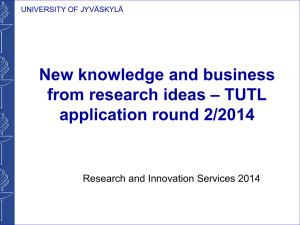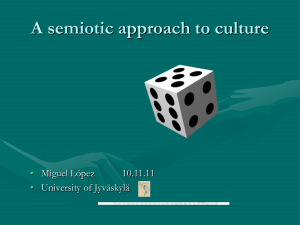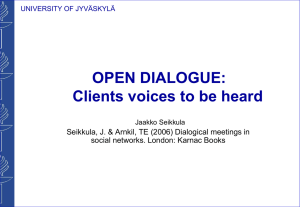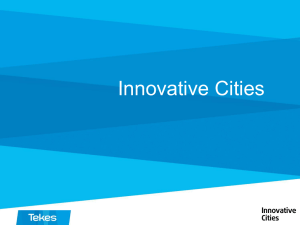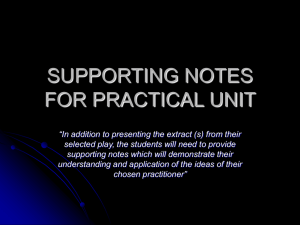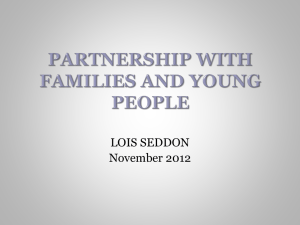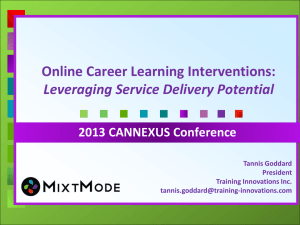Role in guidance
advertisement
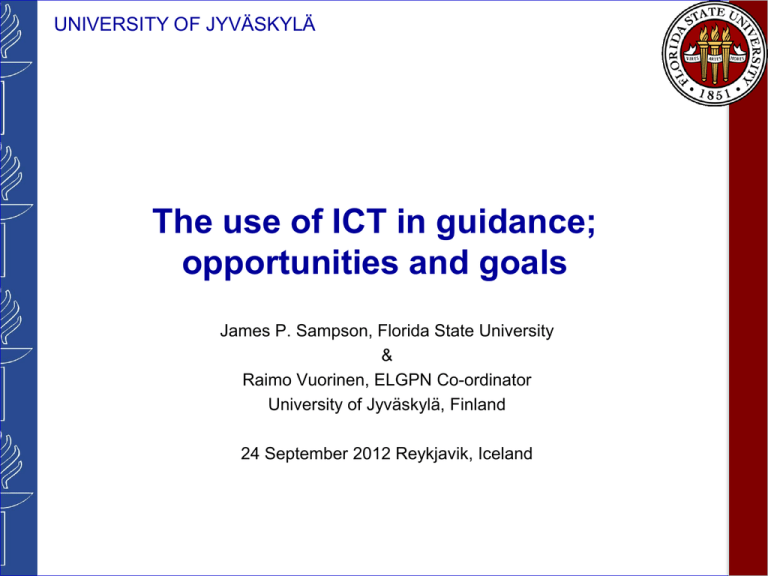
UNIVERSITY OF JYVÄSKYLÄ The use of ICT in guidance; opportunities and goals James P. Sampson, Florida State University & Raimo Vuorinen, ELGPN Co-ordinator University of Jyväskylä, Finland 24 September 2012 Reykjavik, Iceland UNIVERSITY OF JYVÄSKYLÄ Current paradigm of lifelong guidance and the implications to the use of technology UNIVERSITY OF JYVÄSKYLÄ Introduction During the last years there has been increasing attention across the globe towards lifelong guidance. The move from “education and training” to learning changes the focus from structures and institutions to development of individual lifelong career management skills (Watts, Sultana, & McCarthy 2010). UNIVERSITY OF JYVÄSKYLÄ Introduction 2 Well-functioning guidance systems improve education, training & labour market efficiency & effectiveness (lower drop-out, higher productivity, addressing skills shortages and emerging competence areas) The priorities in the EU 2020 key strategies and the Flagship initiatives imply the active role of citizens through acquistision of CMS The role and locus of lifelong guidance in this respect needs to be more widely recognized! UNIVERSITY OF JYVÄSKYLÄ Introduction 3 Increased use of Information and Communication Technology (ICT) highlighted as an essential component for widening access to lifelong guidance services A consensus has emerged that both the counsellor and ICT have an important role to play in the delivery of enhanced career guidance services within the Internet. (Vuorinen 2006). Practitioner perceptions of role of technology will have an impact on how their practice will evolve. UNIVERSITY OF JYVÄSKYLÄ Definition of Lifelong Guidance? What? Activities: e.g.information giving, advice, counselling, assessment, teaching, advocacy For whom/With who? All citizens When? Any age and point in their lives Focus? Making meaningful life choices on learning and work. Empowerment to manage learning and career Career? Individual lifepaths in learning, in work and in other settings in which these capcities and competences are learned and/or used Where? Education, training, employment, community, private – EU Council of Ministries Resolution on lifelong guidance 2004 UNIVERSITY OF JYVÄSKYLÄ Lifelong Career Management Skills “Career management skills refer to a whole range of competences which provide structured ways for individuals and groups to gather, analyse, synthesise and organise self, educational and occupational information, as well as the skills to make and implement decisions and transitions.” – ELGPN WP1 reflection note (Sultana 2009) 7 UNIVERSITY OF JYVÄSKYLÄ Emergence of ICT in guidance Processing of career assessments by mainframe computers and minicomputers, Local delivery of career assessments, information, and instruction on personal computers, Distance delivery of career assessments, information, and instruction on the Internet Distance service delivery Social media via the Internet. UNIVERSITY OF JYVÄSKYLÄ Contexts for ICT applications in guidance Usage of existing Internet-based services and resources within the individual guidance process (searching and obtaining information, self assessment exercises, decision making, action plans) with or without the practitioner Communication with clients using Internet-based technology Development of interactive web-based career tools and digital portfolios Personal Learning Environments, shared documents, communication with peers Usage of web-based learning environments in providing careers education programmes (or managing counsellor training programmes) UNIVERSITY OF JYVÄSKYLÄ Contexts for ICT applications in guidance Usage of institutional web-sites or portals in managing guidance information and resources Evaluation of guidance services Promoting the usage of ICT and co-operation among practitioners and stake holders (e.g. Social media) Creating a common conceptual framework for national guidance system Promoting policies on guidance and counselling UNIVERSITY OF JYVÄSKYLÄ Similarities and differences in the perceptions of practitioners in the use of ICT in guidance in Finland 2001-2002 and 2010 (Vuorinen, Sampson & Kettunen 2011) SIMILARITIES Practitioners were motivated in their use of Internet in guidance ICT was used in delivering career information rather than promoting career management skills from a lifelong guidance perspective Lack of coherent strategies for the use of ICT Need for peer support and ongoing in-service training Concern of equal access and ethical issues Existing career information is fragmented in Internet DIFFERENCES Today students have better access to the Internet and better ICT literacy. Increased ICT resources and services Internet has replaced printed materials as information source Perceived external pressure to increase the use of Internet and social media Practitioners use Internet more extensively More advanced administration software Need for differentiated service delivery mode is observed and acknowledged Gap among students between low readiness and high readiness has increased Chanced nature of Internet due the social media and web 2.0 UNIVERSITY OF JYVÄSKYLÄ Career Practitioners´ Conceptions of Social Media in Career Services Jaana Kettunen and Raimo Vuorinen, University of Jyväskylä, Finland & James P. Sampson Jr., Florida State University, USA UNIVERSITY OF JYVÄSKYLÄ Defining the social media “Social media is a process, where individuals and groups build up a common understanding and meanings with contents, communities and web 2.0 techology.” Content Social media Sources: Kangas et al. (2007) and Ahlqvist et al (2010) Community Web 2.0 UNIVERSITY OF JYVÄSKYLÄ Defining the social media “form of communication which makes use of information networks and information technology and deals with content created by users in an interactive way and in which interpersonal relationships are created and maintained” Source: Finnish Terminology Center (2010) UNIVERSITY OF JYVÄSKYLÄ Results Five distinct categories of description reflecting the career practitioners’ conceptions of social media in career services Kettunen, J., Vuorinen, R., Sampson, J., Jr. (2012). Career practitioners´ conceptions of social media. Submitted for publication. UNIVERSITY OF JYVÄSKYLÄ Results Career practitioners’ conceptions of social media in career services CATEGORIES DIMENSIONS OF VARIATION unnecessary dispensable possibility Attitude Role in guidance Settings Perceptions Nature of interaction Guidance locus Guidance paradigm Role of practitioner Kettunen, Vuorinen & Sampson 2012. desirable indispensable UNIVERSITY OF JYVÄSKYLÄ Category 1: Social media in career services is unnecessary Attitude negative Role in guidance not relevant Settings everyday setting for young people´s lives Perception threat Guidance locus supplier driven, time and space specific Guidance paradigm individual face to face guidance Role of practitioner expert role Nature of interaction practitioner individual “It gives the impression that one has to hang out there nightly, and I wonder who would want it that way?” UNIVERSITY OF JYVÄSKYLÄ Category 2: Social media in career services is dispensable Attitude sceptical Role in guidance passing fad Settings setting for creating and sustaining connections Perception challenge Guidance locus supplier driven, time specific Guidance paradigm individual guidance Role of practitioner advising role Nature of interaction practitioner individual “So this Facebook, it might historically be kind of short phenomenon… maybe it has been given excessive significance…” UNIVERSITY OF JYVÄSKYLÄ Category 3: Social media in career services is a possibility Attitude unsure Role in guidance potentially useful means Settings setting for discussions Perception change Guidance locus demand driven, time specific Guidance paradigm individual and group guidance Role of practitioner supporting role Nature of interaction practitioner individual “….we don´t quite know how we would take it….” UNIVERSITY OF JYVÄSKYLÄ Category 4: Social media in career services is desirable Attitude positive Role in guidance complementary tool Settings setting for reflective thought Perception reality Guidance locus citizen/user-centred, time specific Guidance paradigm individual and group guidance (with or without practitioner) Role of practitioner reflexive role Nature of interaction practitioner individual individual peers “There could be developed, some kind of significant career services in there and for sure some already exists.” UNIVERSITY OF JYVÄSKYLÄ Category 5: Social media in career services is indispensable Attitude Positive/excited Role in guidance way to extend service Settings setting for people processing on their life “We as practitioners should be present there where our clients and youth process their life questions.” Perception positive potential Guidance locus citizen/user-centred Guidance paradigm self-help approach Role of practitioner one resource among others on individuals life Nature of interaction individual practitioner individual community member group (without or with practitioner) UNIVERSITY OF JYVÄSKYLÄ Kettunen, Vuorinen & Sampson 2012 UNIVERSITY OF JYVÄSKYLÄ Using Information and Communication Technology to Integrate Face-to-Face and Distance Guidance UNIVERSITY OF JYVÄSKYLÄ Service Delivery at a Distance Deliver services through the use of e-mail, chat, telephone, or videoconferencing Delivered to persons who may – be underserved with face-to-face services – prefer the convenience of remote assistance 35 UNIVERSITY OF JYVÄSKYLÄ Distance Guidance as a Necessity Persons with disabilities who have mobility problems Persons in remote geographic areas who lack access to resources and services Persons seeking access to practitioners in other locations with specialized expertise Persons reluctant to seek help who use the Internet as a safe place to start obtaining resources and services 36 UNIVERSITY OF JYVÄSKYLÄ Distance Guidance as a Convenience Persons who want to access resources and receive services outside of normal business hours Persons who want to access resources and receive services at their place of residence or work 37 UNIVERSITY OF JYVÄSKYLÄ Three Levels of Service Delivery at a Distance Self-help services – Responding to questions about Web-site use Brief staff-assisted services – Screening, recommending, orienting, and follow-up of Web-site use Individual case-managed services – Individual guidance at a distance 38 UNIVERSITY OF JYVÄSKYLÄ Web Sites All levels of service delivery can make use of Web sites that provide – remote access to career assessments and career information – links and referrals to career services In brief staff-assisted and individual case- managed services, specific content on a Web site can be assigned on the ILP 39 UNIVERSITY OF JYVÄSKYLÄ Web Sites A career center or school Web site can be used by young people and adults in the career resource room as well as at a distance Staff modeling of Web site use can stimulate the information-seeking behavior of young people and adults 40 UNIVERSITY OF JYVÄSKYLÄ Web Sites and Distance Guidance Practitioner can refer an adolescent or adult to specific content on a Web site that relates to a problem being discussed The “teachable moment” provides practitioners with an opportunity to help individuals immediately process and apply what they are learning 41 UNIVERSITY OF JYVÄSKYLÄ Pyramid of Information Processing Domains Thinking about my decision making Client Version Knowing how I make decisions Knowing about myself Knowing about my options What you need to know to make a career choice UNIVERSITY OF JYVÄSKYLÄ CASVE Cycle - Client Version Knowing I Need to Make a Choice Knowing I Made a Good Choice Implementing My Choice Choosing An Occupation, Program of Study, or Job Understanding Myself and My Options Expanding and Narrowing My List of Options What you need to do to make a career choice UNIVERSITY OF JYVÄSKYLÄ Translating Concepts for Client Use Pyramid – What’s involved in career choice – A guide to good decision making – The content of career choice – The process of career choice – What you need to know – What you need to do – Goal – making an informed choice 44 The CASVE Cycle – Goal – making a careful choice UNIVERSITY OF JYVÄSKYLÄ Differentiated Service Delivery Instead of one level of service for all, three levels of service are needed to meet individual needs ranging from those who are: – self-motivated and able to learn successfully on their own – suffering from low readiness for decision-making who need substantial assistance to successfully learn 45 UNIVERSITY OF JYVÄSKYLÄ Differentiated Service Delivery The three levels of service include – Self-help services for young people and adults with high readiness for decision making – Brief staff-assisted services for young people and adults with moderate readiness – Individual case-managed services for young people and adults with low readiness 46 UNIVERSITY OF JYVÄSKYLÄ Definition of Readiness Readiness is the capability of an individual to make informed and careful career choices taking into account the complexity of family, social, economic, and organizational factors that influence career development Readiness also includes possessing adequate language skills and literacy skills for communication and learning 47 UNIVERSITY OF JYVÄSKYLÄ Two-Dimensional Readiness Model Complexity (high) Low readiness High degree of support needed (Individual CaseManaged Services) Capability (low) Moderate readiness Moderate to low degree of support needed (Brief Staff-Assisted Services) (high) Moderate readiness Moderate to low degree of support needed (Brief Staff-Assisted Services) High readiness No support needed (Self-Help mode) (low) UNIVERSITY OF JYVÄSKYLÄ Aim of Differentiated Service Delivery Young people and adults should receive the level of help they need, no more and no less The aim of the differentiated service delivery model (the CIP approach) is to provide – the right resource – used by the right person – with the right level of support – at the lowest possible cost 49 UNIVERSITY OF JYVÄSKYLÄ Differentiated Service Delivery Model Individual Enters Brief Screening Self or Staff Referral Comprehensive Screening Self-Help Services Brief Staff-Assisted Services Individual Case-Managed Services Complete differentiated model of delivering career resources and services UNIVERSITY OF JYVÄSKYLÄ A Generic Sequence for Services 1. Intake 2. Screening 3. Problem identification 4. Goal setting 5. Service delivery planning 6. Resource and service use 7. Problem review 51 UNIVERSITY OF JYVÄSKYLÄ Common Elements of Face-to-Face and Distance Guidance Web Site Resource Guides Diagnostic Assessment Individual Learning Plans Information Handouts UNIVERSITY OF JYVÄSKYLÄ Ethical Issues Informed consent Client suitability Client access and financial capability Counselor competence Training Credentialing 53 UNIVERSITY OF JYVÄSKYLÄ Ethical Issues Client technology skills Confidentiality Cultural sensitivity Limited awareness of location-specific issues Lack of clarity about practitioner credentials 54 UNIVERSITY OF JYVÄSKYLÄ Web Site Ethical Issues Violation of confidentiality or security Links to invalid assessments and information Lack of practitioner support when needed Practitioner dependency on the Web site to compensate for a lack of competency Individuals with little access to the Internet due to a lack of financial resources 55 UNIVERSITY OF JYVÄSKYLÄ Models for Designing and Using Distance Guidance UNIVERSITY OF JYVÄSKYLÄ Coping With Overwhelming Information Internet Web sites are an increasingly popular source of information Easy to become overwhelmed by the amount and diversity of information on the Internet Make very selective use of Web sites as homework resources 57 UNIVERSITY OF JYVÄSKYLÄ Coping With Overwhelming Information Use a model that helps clients limit the scope of information by linking Web site content with specific client goals 60 UNIVERSITY OF JYVÄSKYLÄ Model for Client Web-Site Use Three goals for client use of Web sites 1. Help the client to understand the nature of his or her problem 2. Assist the client to act in ways that help to solve his or her problem 61 3. Help the client to better cope with problems that cannot be completely solved UNIVERSITY OF JYVÄSKYLÄ Web vs. Practitioner-Based Information Practitioners can give clients information or refer them to valid information from carefully selected Web sites There are benefits in providing information to clients via the Internet 71 UNIVERSITY OF JYVÄSKYLÄ Web vs. Practitioner-Based Information Web-based information may be more current and more complete than information provided by a practitioner – Assumes that the information provided on the Web is valid – This assumption is not always true Obtaining Web-based information may reduce 72 the expectation that the practitioner’s role is to provide expert information after the client carefully explains his or her problem UNIVERSITY OF JYVÄSKYLÄ Web vs. Practitioner-Based Information Clients may react negatively to information provided by a practitioner and engage in “Yes, but…” interactions Emphasize a collaborative role – The practitioner focuses on helping the client find and effectively use information, rather than emphasizing an authoritarian role where the practitioner focuses on providing information May reduce negative responses to perceived 73 “advice” given by an authority figure UNIVERSITY OF JYVÄSKYLÄ Web vs. Practitioner-Based Information Making greater use of Web-based information may help the practitioner become less focused on being knowledgeable about an ever increasing amount of information Helping clients better understand why they are reluctant to use the information they have obtained is a better use of time in counseling 74 UNIVERSITY OF JYVÄSKYLÄ Web vs. Practitioner-Based Information Help clients assume more responsibility for decision making since they are not dependent on the practitioner for getting access to information Learning how to obtain and effectively use information may help the client to be a better problem solver in the future 75 UNIVERSITY OF JYVÄSKYLÄ Web vs. Practitioner-Based Information The practitioner will always provide information to clients – Some information is so specific or localized that it is not available on the Internet The practitioner needs to judge when to provide information to the client and when to recommend that the client obtain information from a specific portion of a Web site 76 UNIVERSITY OF JYVÄSKYLÄ Role of the Practitioner The role of the practitioner is shifting from providing information to collaboratively helping clients find and effectively use information 77 UNIVERSITY OF JYVÄSKYLÄ Four-Step Counseling Model A four-step counseling model can help clients effectively use a Web site in completing homework 1. Screening 2. Recommending 3. Orienting 4. Follow-up 78 UNIVERSITY OF JYVÄSKYLÄ For discussions What kind of tools and resources would you need to make this happen? What kind of training would you need to be successful? How do the current guidelines for practice need to change to make this happen or do they need to change? UNIVERSITY OF JYVÄSKYLÄ For more information www.career.fsu.edu/techcenter

